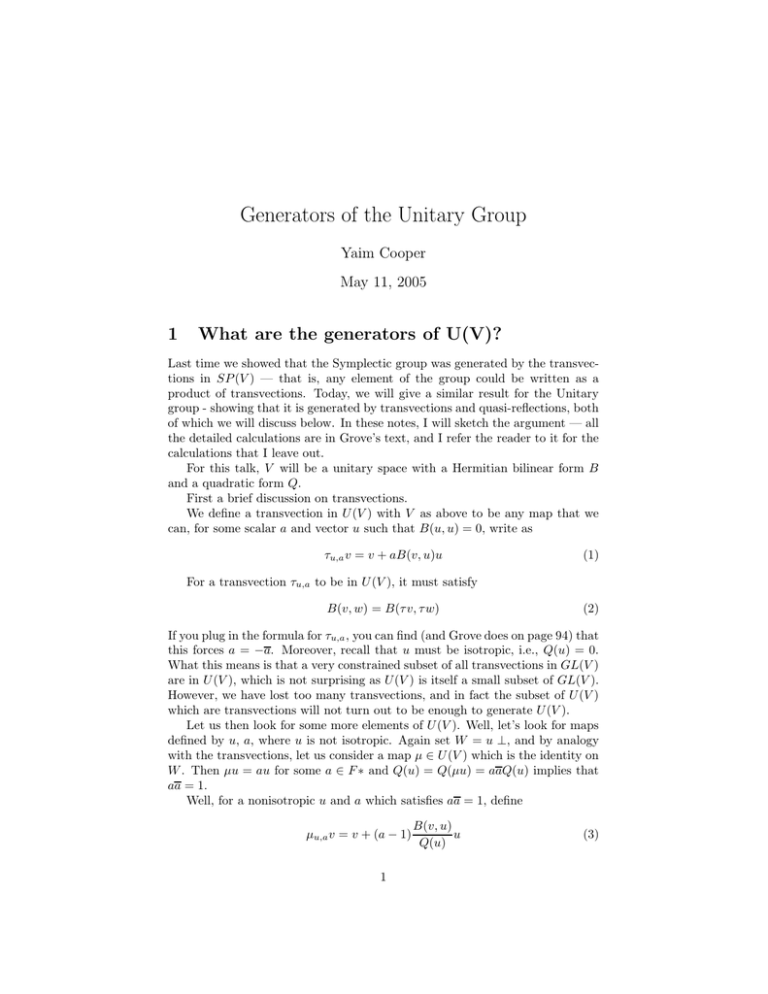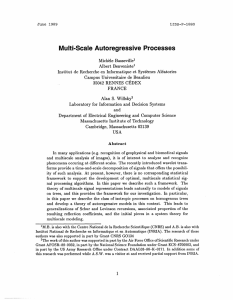Generators of the Unitary Group 1 What are the generators of U(V)?
advertisement

Generators of the Unitary Group
Yaim Cooper
May 11, 2005
1
What are the generators of U(V)?
Last time we showed that the Symplectic group was generated by the transvections in SP (V ) — that is, any element of the group could be written as a
product of transvections. Today, we will give a similar result for the Unitary
group - showing that it is generated by transvections and quasi-reflections, both
of which we will discuss below. In these notes, I will sketch the argument — all
the detailed calculations are in Grove’s text, and I refer the reader to it for the
calculations that I leave out.
For this talk, V will be a unitary space with a Hermitian bilinear form B
and a quadratic form Q.
First a brief discussion on transvections.
We define a transvection in U (V ) with V as above to be any map that we
can, for some scalar a and vector u such that B(u, u) = 0, write as
τu,a v = v + aB(v, u)u
(1)
For a transvection τu,a to be in U (V ), it must satisfy
B(v, w) = B(τ v, τ w)
(2)
If you plug in the formula for τu,a , you can find (and Grove does on page 94) that
this forces a = −a. Moreover, recall that u must be isotropic, i.e., Q(u) = 0.
What this means is that a very constrained subset of all transvections in GL(V )
are in U (V ), which is not surprising as U (V ) is itself a small subset of GL(V ).
However, we have lost too many transvections, and in fact the subset of U (V )
which are transvections will not turn out to be enough to generate U (V ).
Let us then look for some more elements of U (V ). Well, let’s look for maps
defined by u, a, where u is not isotropic. Again set W = u ⊥, and by analogy
with the transvections, let us consider a map µ ∈ U (V ) which is the identity on
W . Then µu = au for some a ∈ F ∗ and Q(u) = Q(µu) = aaQ(u) implies that
aa = 1.
Well, for a nonisotropic u and a which satisfies aa = 1, define
µu,a v = v + (a − 1)
1
B(v, u)
u
Q(u)
(3)
You can check that µu,a ∈ U (V ), µu,a u = au and µu,a restricted to W is the
identity. So this is what we ordered in the previous paragraph, when looking
for a analog to the transvection τu,a when u is nonisotropic. Such a map µu,a is
called a quasi-reflection along u by Grove, because for charF 6= 2, µu,−1 is the
familiar reflection along u.
2
Another way to write the above generators
Now there is a very clever construction which allows us to treat transvections
and quasi-reflections on the same footing. It is a bit complicated to follow,
though, so careful:
For any σ ∈ U (V ) let σ̂ = 1 − σ.
Define the subspace Vσ of V by
Vσ = σ̂V = {v − σv : v ∈ V }
(4)
σ ∈ U (V ) implies that
B(σ̂x, σ̂y) = B(σ̂x, y) + B(x, σ̂y)
(5)
for all x, y ∈ V .
One more definition: for u, v ∈ Vσ , say u = σ̂x and v = σ̂y, define
Bσ (u, v) = Bσ (σ̂u, σ̂v) = B(x, σ̂y)
(6)
One can check that Bσ is well defined and is a sesquilinear form on Vσ
relative to conjugation. However it is not a Hermitian form because instead of
satisfying Bσ (u, v) = −Bσ (v, u), it satisfies
Bσ (u, v) + Bσ (v, u) = B(u, v)
(7)
for all u, v ∈ Vσ .
Moreover, Bσ is nondegenerate, because if Bσ (u, v) = 0 for all u ∈ Vσ , then
B(x, σ̂y) = 0 for all x ∈ V . By nondegeneracy of B on V , this implies that
σ̂y = 0 = v so Bσ is nondegenerate on Vσ .
Take a basis {v1 ...vr } be a basis for Vσ , and let Bˆσ be the matrix of Bσ with
−1
respect to this basis, as usual, i.e., Bˆσ = [Bσ (vi , vj )]. Let A = [aij ] = Bˆσ .
Now we can write σ in terms of B and Bσ (derivation straightforward, in Grove):
X
σx = x −
B(x, vi )aij vj
(8)
i,j
3
From a form to the generators of U(V)
So from an arbitrary element σ ∈ U (V ) we have constructed a bilinear form Bσ
on Vσ . We would like to now go in the opposite direction. The essential thing
about the previous section was this form Bσ which was sesquilinear and had
2
this funny property Bσ (u, v) + Bσ (v, u) = B(u, v). Thus we are motivated to
consider the following:
Lemma 1. Suppose that W is a subspace of V and that C is a nondegenerate
sesquilinear form on W satisfying C(u, v) + C(v, u) = B(u, v) for all u, v ∈ W .
Then there is a unique σ ∈ U (V ) such that W = Vσ and C = Bσ .
I omit the proof, which is in Grove on page 96. But such σ will be denoted
σW,C .
Relative to a basis {vi } for W , we have as above,
X
σW,C x = x −
B(x, vi )aij vj
(9)
i,j
for all x ∈ V and A = Bˆσ = Ĉ −1
An illustrative example is, suppose that dim W = 1, i.e., W =< u >. Then
σ( W, C)(x) = x − aB(x, u)u where a = C(u, u)−1 , and thus by our basic constraint on C, a−1 + a−1 = Q(u). If u is isotropic, that becomes a + a = 0
and we see that σW,C is just the transvection τu,−a . On the other hand, if u is
anisotropic, then σW,C is the quasi-reflection σu,c with c = 1 − aQ(u).
−1
4
And now the decomposition of an arbitrary
element of U(V)
First, another lemma:
Suppose that W = Vσ for some σ ∈ U (V ) and let W1 be aL
nondegenerate
Bσ subspace of W . Let W2 = W1 ⊥ in W . Then W = W1 W2 . By our
first lemma, there exist σ1 and σ2 ∈ U (V ) such that Vσi = Wi relative to the
sesquilinear forms Bσ restricted to Wi , for i = 1, 2.
Lemma 2. In such a case, σ = σ2 σ1 .
Again, the proof is in Grove, on page 98.
Finally, we will need the fact, also proved in Grove, that if C is a sesquilinear
form on W relative to conjugation, then there is a basis {wi } for W with respect
to which the matrix of C is upper triangular.
Theorem 3. If 1 6= σ ∈ U (V ) we may factor σ as σ = σr ...σ1 with each σi
either a transvection or a quasi-reflection.
Proof. Chose a basis {wi } for W = Vσ with respect to which Bσ is upper
triangular. Then Let σ1 and σ2 be as in Lemma 2, with respect to < w1 >,
Bσ |<w1 > and < w2 ...wr >, Bσ |<w2 ...wr > . By Lemma 2, σ = σ2 σ1 . As remarked
in our illustrative example, σ1 will be a transvection if w1 is isotropic, otherwise
it will be a quasi-reflection. Finally, the proof follows by induction.
3








